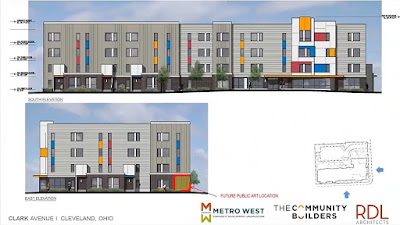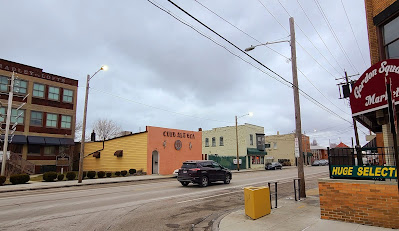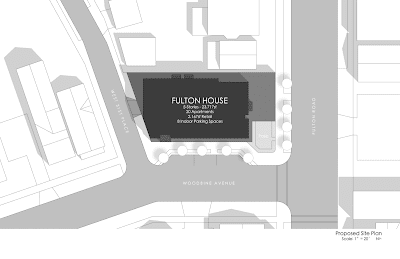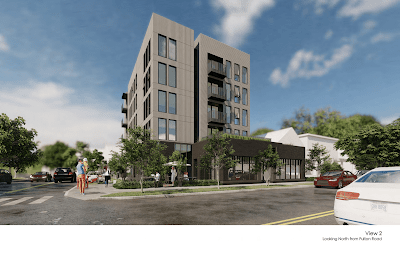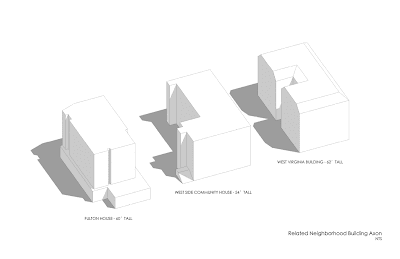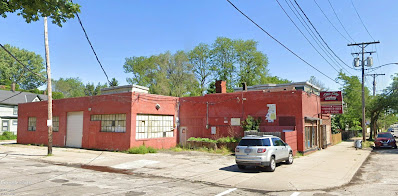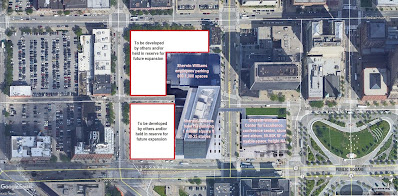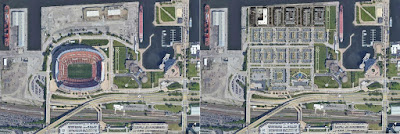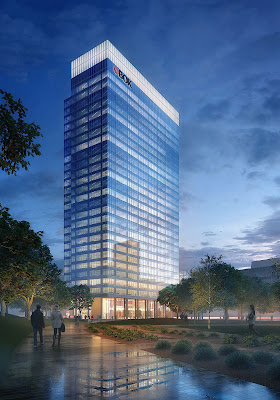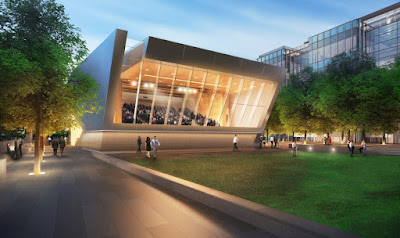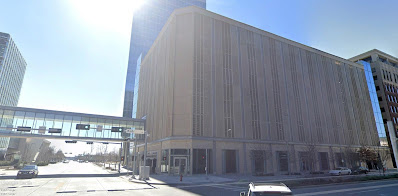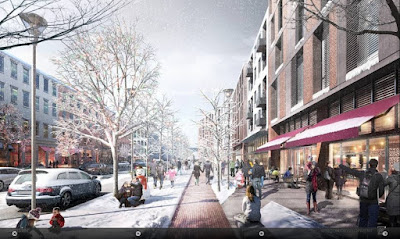Clark Avenue is one of those strange streets in Cleveland with an odd mix of buildings.
It has a lot of older structures. On the sidewalks are storefronts and taverns topped by a few apartments. There's a scattering of light industrial buildings from the 1800s and early 1900s. And then there's all those newer single-use buildings -- mostly fast-food restaurants and small-box stores -- set back behind lots of pavement and empty parking spaces.
One land use that Clark doesn't have are large, multi-story, multi-family residential buildings. That's despite the fact the neighborhood is growing in population and is one of the city's most ethnically diverse.
But that lack of dense housing could change in a few years because of two planned multi-family housing developments. One would convert the former Pilsener Brewing Co. Bottle Works, 6605 Clark, into 39 apartments called Pilsener Square. The other would build a new 50-unit apartment complex on 1 acre of mostly vacant land at the northwest corner of Clark and West 32nd Street called Alta Villa Flats.
If built, both would be the largest housing developments on Clark. The Alta Villa Flats development at 3120 Clark would be the first multi-family residential structure built on Clark since the 1920s, city building records show.
The neighborhood's diversity includes a large and growing Latinx segment and an increasing number of African-Americans, along with a significant number of Central and Eastern European immigrant descendants, according to an October 2019 Clark-Fulton Target Area Plan by the Ohio Housing Finance Agency (OHFA).
| The International Village mural on the west wall of the City Bank Building at Clark Avenue and West 25th Street (OHFA). |
That plan is part is part of a new initiative by OHFA to create mixed-income, diverse and accessible communities in Ohio’s three largest cities. It was begun in 2018, the 50th anniversary of the Fair Housing Act.
In public meetings conducted at the start of OHFA's planning, surveys showed housing was the number-one priority for neighborhood residents.
"A number of suggestions were solicited, such as developing incentives to encourage the redevelopment of vacant structures and also assisting existing homeowners with repairs and energy efficiency upgrades," the report said. "Aggressive code enforcement by the city was also recommended. Given the strength of the market and a growing need for affordable housing, developing additional affordable housing was a top priority of many residents."
Metro West Community Development Organization is sponsoring both of the apartment building developments. It is partnering with Marous Brothers Construction Co. to redevelop the Pilsener Brewing Co. Bottle Works. And it is partnering with The Community Builders Inc. to construct Alta Villa Flats.
On Feb. 1, the Board of Zoning Appeals unanimously approved all of the variances requested by Community Builders to move forward with Alta Villa Flats. Developer's representatives said they could not secure financing, including Low Income Housing Tax Credits (LIHTC), without the variances.
 |
| Location, site plan, potential materials and landscaping for the proposed Alta Villa Flats at 3120 Clark Ave. (RDL/PAB). |
The property's zoning -- general retail and two-family housing -- hadn't changed since 1929, said Margaret Kavourias, project architect at RDL Architects. Furthermore, the 60,383-square-foot apartment building proposed for the 1-acre site has roughly three times the density that's permitted in the zoning code.
"We've identified a need for new and more affordable housing in this area," said Cleveland City Planner Matt Moss. "City Planning Commission would like to rezone the area for more housing."
The site is comprised of seven parcels. The lot at the corner has a former used-car dealership with a still-occupied house behind it. Metro West has a purchase agreement with property owners Hani K. and Samira H. Ziadeh.
Not only was the ancient zoning inappropriate for the proposed apartment building, so was the city's parking requirements. Major cities are increasingly adopting parking maximums. Cleveland still has parking minimums and the minimum for a development of this size on this lot is 50 off-street spaces. A representative of the national developer that has been building mixed-income developments for 60 years said 25 spaces are plenty for a mixed-income apartment building like this.
"We have found through our operational team that, very often, mixed-income housing tends to be overparked because many of our residents cannot afford cars," said Nicole Boyer, senior development project manager at The Community Builders. The firm is America's largest nonprofit developer of urban mixed-income housing.
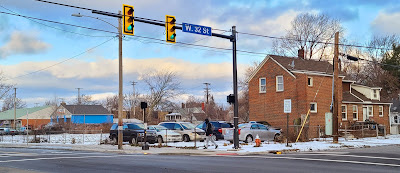 |
| Proposed site for Community Builders' new four-story apartment building would eradicate this house and a vacant lot used most recently as a used-car dealership (KJP). |
She said their tenants often depend on public transportation to reach their jobs and walk to nearby shopping. Community Builders also likes to locate their projects within close proximity to employment centers such as the new $1 billion MetroHealth Medical Center, Boyer added.
"Our historic data has shown that parking ratios of anywhere from 50 to 60 percent of the overall unit count are more than sufficient and often times those parking spaces are still underutilized," she said. "We think that the close proximity to the bus line on Clark Avenue which connects to some of the more prominent Rapid (transit) lines in Cleveland is a really great amenity for our residents."
The Alta Villa Flats development will also feature a covered bicycle parking area and have a Greater Cleveland Regional Transit Authority bus stop in front of the new apartment building.
Following a systemwide redesign by the Greater Cleveland Regional Transit Authority, the bus route that is tentatively proposed to operate on Clark starting in June will be the No. 25 bus, starting at Public Square downtown, traveling through Ohio City, Tremont, Steelyard Commons, Clark, Madison Avenue and ending at the Westgate Transit Center in Rocky River. It is proposed to operate every 30 minutes throughout the day.
Metro West is also pursuing a district-wide parking plan for the neighborhood, said Ricardo León, executive director of the community development corporation. When implemented, that plan would allow for shared parking with other lots to absorb possible parking overflow and guest parking.
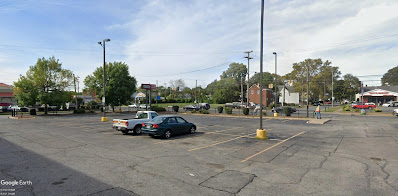 |
| Plenty of underutilized parking areas exist along Clark Avenue including this one for an auto parts store across the street from the site of the proposed Alta Villa Flats (Google). |
"We've found that only 30 percent of parking in the area is used," said León.
Community Builders will also construct a pocket park due to what León called "a lack of robust greenspace in the neighborhood." He said there is a potential for a lighted play area and landscaping features like a sculpture that kids can climb on. On-site management will be provided by Community Builders.
Construction timeline for the roughly $15 million Alta Villa Flats depends on when financing is awarded. Boyer said that construction would start roughly one year after all of the project's funding is secured. Although a neighborhood's design-review committee approved the project's conceptual design, the more refined designs by RDL Architects won't be submitted for approval until after the funding is in hand.
Meanwhile, last May, Cleveland's City Planning Commission and City Council awarded landmark status to the historic Pilsener Brewing Co. Bottle Works to help it win historic tax credits and LIHTCs. With those funds, the sturdy brick and masonry building would be converted into the Pilsener Square Apartments.
However, the $12.27 million project missed out on opportunities to win a $817,050 competitive New Affordability tax credit from OHFA last year. There were 11 applicants in Cuyahoga County alone; OHFA funded four of them in 2020. Pilsener Square sponsors are reapplying for 2021 awards. Historic tax credit applications are still pending.
Financing for the project will include low-income housing tax credit equity, OHFA's Housing Development Assistance Program, permanent mortgage, Federal Home Loan Bank's Affordable Housing Program funds, Cleveland Housing Trust Fund, federal HOME Investment Partnership block grants administered by Cuyahoga County plus a deferred developer fee, according to Pilsener Square's proposal summary.
The 53,550-square-foot Bottle Works was added in 1914 to the Pilsener Brewing Co.'s sprawling plant at Clark and West 65th Street, called Pilsener Square. The brewery was started in 1892 and expanded rapidly with additional structures that are no longer standing except the Bottle Works. The company which brewed P.O.C. beer and other once-popular brands closed in 1984.
Two upper levels of the structure could be used for apartments averaging about 900 square feet each. Indoor parking and residents' amenities such as a community room, laundry facilities, resident lounge and atrium are proposed mostly on the lower level which is below street level next to Clark. On the south side of the street, the land slopes downward away from Clark.
The name "Pilsener" comes from the Czech city of Pilsen, where the light Bohemian lager beer was first made. Just southeast of Pilsen is where the brewery's founder, Wenzel Medlin, was born -- Mecichov, South Bohemia, Czech Republic, in 1849.
Tyler Kapusta contributed to this article.
END

